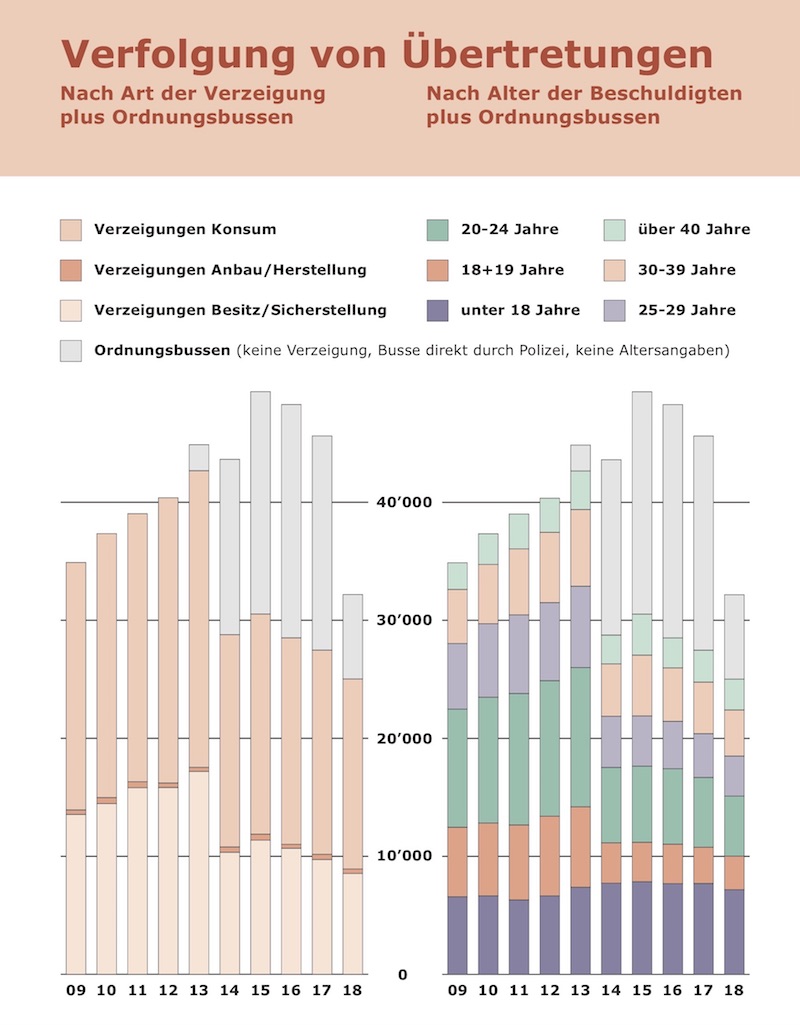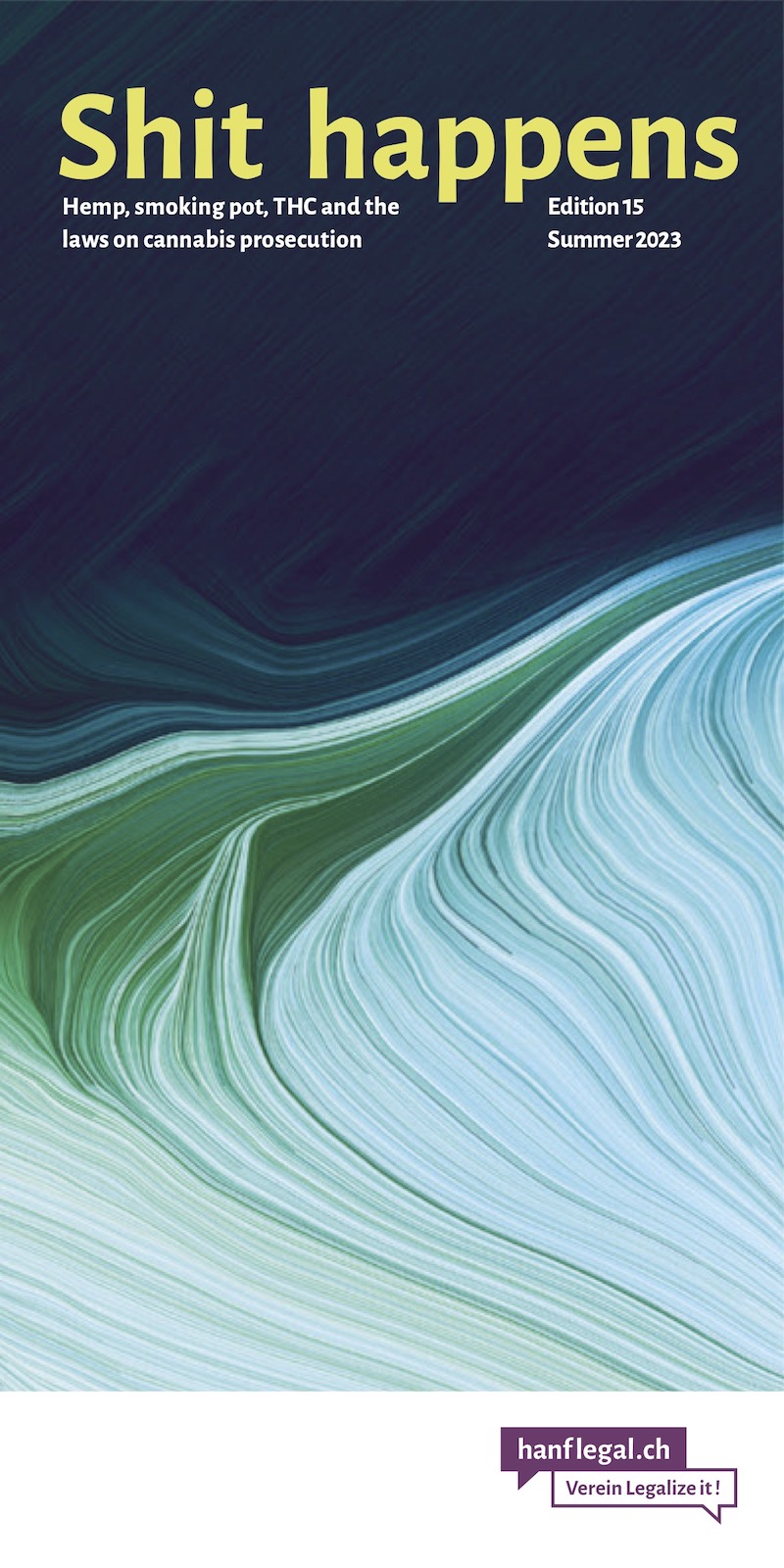- THC & Law:
Prosecution 2018: The first crack in repression?
The number of fines issued has decreased massively, the number of convictions around consumption has decreased slightly and the number of convictions for misdemeanor has increased. We summarize the 10th year of the new census.
Still tens of thousands affected
2018 was now the 10th year of the new counting method by the Federal Statistical Office (FSO). For hemp contraventions, 29,137 offenses were counted, which were assigned to 25,023 defendants. In addition, there were 7,153 fines.
In the case of minor hempmisdemeanor, 8,751 offences were recorded, committed by 7,766 defendants, and in the case of more serious hempmisdemeanor, 285 offences were recorded with 275 defendants.
Dramatic decline of fines in 2018
While around 15,000 to 19,000 OBs were issued in each of the years from 2014 to 2017, there was a drop in 2018 to just 7,153. That's really stark.
We can't be completely sure, but everything points to the fact that the OBs that were dropped affected the possession of a minor quantity (which is actually exempt from punishment according to the law).
This is because the number of convictions for contraventions has also fallen somewhat (see also graphs below). This means that the punishment of the unpunished quantity has really been abandoned (otherwise the number of convictions would have had to rise again).
We can't say this for sure for all cantons - smaller ones might well make referrals in cases of a minor quantity without this being reflected in the statistics, because these cantons count very few cases. But broadly, the 2017 Federal Court ruling (see LI79) seems to have been convincing.
The first step back?
This really is almost a miracle. For decades, the police and the public prosecutor's offices have always maintained that the minor quantity does not have to be taken into account. The municipal magistrate's office in Zurich even had copies of the legal texts with handwritten notes at hand, which they gave to all those who wanted to insist on the impunity of the minor quantity.
There simply was to be nothing impunity-free, although it was so stated in the law. And mind you, it had been there for decades (only the limit of 10 grams was introduced in 2013). So in the last few years tens of thousands of fines were wrongly issued and in the years before that probably tens of thousands of reprimands were wrongly issued.
Is this now the first crack in repression? The first step backwards? It could be. Of course, if police forces and public prosecutors abide by the law, that's not a breakthrough. But if you think about how important it has always been for them to prosecution even the unpunished acts, then it is a big step.
There would be other facilitations....
Incidentally, the Federal Court ruling called to mind other provisions of the NarcA: There is not only the punishable amount for personal consumption, there is also the easy case and the possibility of dropping a case as well as the possibility of a warning. However, these points are still practically never applied, although the Federal Court actually recommends it.
Infraction reprimands in the previous framework
But the OB are only a small part of the repression. The main part is made up of the reprimands, which is clearly visible in the graphics below.
First the two graphs about the contraventions: On the left, the convictions in the three categories of the FSO and the OB, and on the right, the same figures, but broken down by age group. We can see very clearly how the OBs have paid off, especially for young consumers: Their conviction rate has practically halved with the introduction of OB. This does not apply to minors, however, because they cannot receive OB and are always referred to the Office of the Juvenile Prosecutor. Older people have also benefited somewhat from OB, but the decline is far less marked.
For the young, it is also often just a matter of using in public and carrying around some weed or hash. When people over 40 get involved with the police because of hemp, it is more often about more complex things (growing in their own garden, ordering hemp seeds, quantities over 10 grams).
Misdemeanor convictions on the climb
We also see this in both graphs on the misdemeanor. On the right, misdemeanor referrals for severity, and on the left, the same misdemeanor referrals, again broken down by age group.
Here we see that the proportion of older people is much higher than in the case of contraventions. We can also clearly see the large number of people over 40 who were reported for an offense in 2015: To a large extent, these were people who had ordered a few hemp seeds for their own consumption and were then reported by customs for a misdemeanor.
Also special is the growing number of young people who are prosecuted for a cannabis offense. The distribution of cannabis to young people is, after all, a misdemeanor. However, instead of the evil dealers, this provision, as was to be expected, mainly affects young people who pass on a joint to others or young people who shop together.
By the way: The hemp seed prosecution by customs still continues! But more about this in the next LI, where we also want to deal with the ratio of hash- to weed-convictions.
Many seizures
Now we still bring the overview of the 2018 seized substances in the hemp sector: over 2 tons of hemp, 49,000 hemp plants, 19,000 seeds. Even if the list is a bit confusing and various points are questionable, it gives an impression of what all was seized. Compared to 2017, almost one ton less weed was seized, but a lot more hash and also hemp seeds.
Source
Swiss Federal Statistical Office (SFSO), Police Crime Statistics, Annual Reports 2009 to 2018. Graphical representation by us.
Comments on the data
The figures for the number of convictions by type of contravention or misdemeanor differ slightly from those for age: there are some individuals for whom no age could be assigned. Therefore, the numbers by age are a bit smaller (in the graphs you can actually only see it in the misdemeanor 2018).
Effectively, the hemp conviction numbers are likely to be about 5% higher because the FSO category “Multiple” includes cases with multiple hemp products, but is not fully broken down. Therefore, we omit it.
The fixed penalties figures were subsequently adjusted by the FSO. We now use these new figures, except in 2014, where we add the first report from the canton of Geneva (the FSO did not update the number of OB in Geneva in 2014).
In general, it must be said that the statistics are not above suspicion. In many cases, the categorizations do not make sense, the number of convictions is not broken down by canton, and much more.
Nevertheless, we think that these figures give an interesting insight into the sheer amount of people involved, the repressive actions as well as the quantities seized.
reprimands and summary penalty orders
These statistics contain the police reprimands as well as the fines. If you want to see what concrete punishments this then leads to, you can find examples on our hanflegal.ch/strafebefehle.
Support our work with a donation:
Bank transfer
Account number (IBAN):
CH02 0900 0000 8709 1354 3
Full account details
Or scan this QR code with your eBanking App (ZKB, Revolut, Postfinance, …):

Or open/share the QR code as PDF file with your eBanking App.
Credit card
Donate via credit card
Verein Legalize it!
Quellenstrasse 25
8005 Zürich
Threema ID 7NH65RBY
Don’t miss anything! Follow us on social media:



